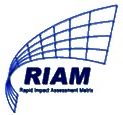Rapid Impact
Assessment Matrix
Is a powerful Impact Assessment system that organises and analyses the components selected by the scoping of any holistic environmental impact assessment.

Why RIAM

The RIAM method provides a completely transparent record of the judgements made in the process, coupled with a fast analysis system and results that can be simply presented.

RIAM has successfully been used for Initial Environmental Evalution (IEE) and Environmental Impact Assessment (EIA), as well for Strategic Environmental Assessment (SEA) and Regional Environmental & Social Assessment (RESA).

RIAM can be used for a wide range of Impact Assessments at different levels of decision making and planning.

RIAM may be adapted for use in Sustainability Appraisal (SA), evaluation of performance and for programme/project prioritisation.
Introduction & Brief History
The concept of RIAM was developed by Christopher Pastakia in the late 1980’s, and coalesced into a system to demonstrate the degree of change in engineering project options and interventions. This was applied first in water resource and river management projects in Bangladesh in 1991-92.
In 1993 when Chris Pastakia joined the Danish Water Quality Institute (VKI) as Senior Environmental Advisor, he led a small team that further researched, tested and developed the impact assessment system he brought with him, and the named changed to RIAM at this time.
The method became a standard system for environmental impact assessment in VKI, and was taught to participants from a wide number of developing countries in the Institute’s Environment & Water Management Course.
In the year 2000 VKI merged with the Danish Hydraulic Institute (DHI) to form DHI Water & Environment.

Most members of the VKI team that worked with Christopher Pastakia on RIAM have now left VKI and its new organisation (after merging with the Danish Hydraulic Institute). The main early collaborators were:

(* Kurt and Jesper are now sadly deceased)
